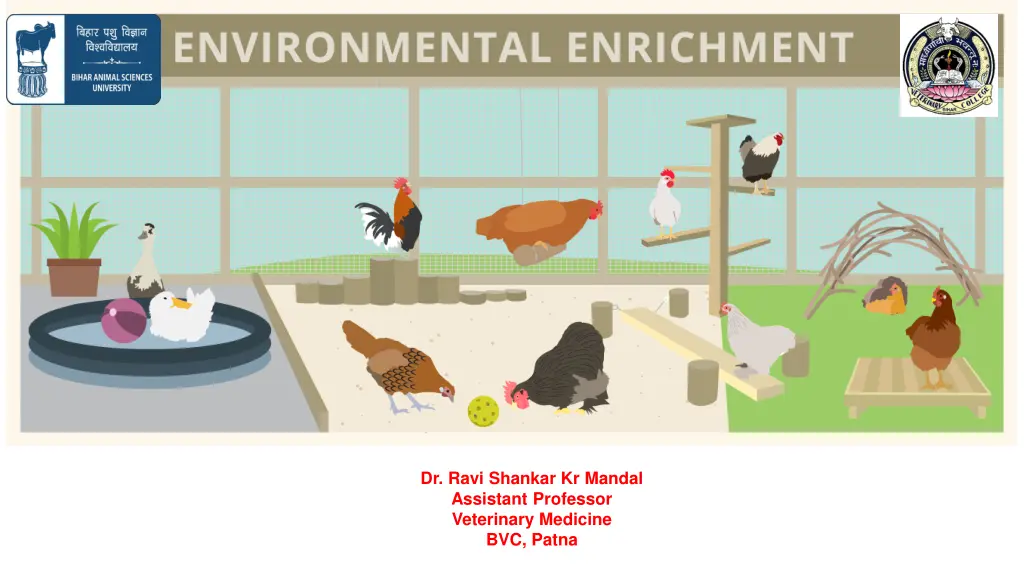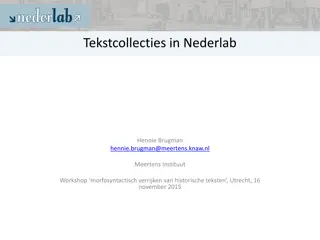
Improving Animal Welfare Through Environmental Enrichment
Enhance animals' physical and psychological well-being through environmental enrichment by encouraging natural behaviors, reducing stress, and promoting species-appropriate activities. Learn about the goals, importance in veterinary practice, types of enrichment, and feeding enrichment techniques.
Download Presentation

Please find below an Image/Link to download the presentation.
The content on the website is provided AS IS for your information and personal use only. It may not be sold, licensed, or shared on other websites without obtaining consent from the author. If you encounter any issues during the download, it is possible that the publisher has removed the file from their server.
You are allowed to download the files provided on this website for personal or commercial use, subject to the condition that they are used lawfully. All files are the property of their respective owners.
The content on the website is provided AS IS for your information and personal use only. It may not be sold, licensed, or shared on other websites without obtaining consent from the author.
E N D
Presentation Transcript
ENVIRONMENTAL ENRICHMENT Dr. Ravi Shankar Kr Mandal Assistant Professor Veterinary Medicine BVC, Patna
ENVIRONMENTAL ENRICHMENT Process of improving an animal's environment to enhance its physical and psychological well-being by encouraging natural behaviors and reducing stress One of the most powerful tools an animal caretaker has to improve welfare for an individual Generally relate to adding sensory stimuli or providing choices in the environment The provision of stimuli which promote the expression of species-appropriate behavioral and mental activities in an under stimulating environment GOALS FOR ENRICHMENT Increase behavioral diversity Reduce the frequencies of abnormal behavior Increase the range of normal (i.e., wild) behavior patterns Increase positive utilization of the environment Increase the ability to cope with challenges in a more normal way
GOALS FOR ENRICHMENT Encourage natural behaviors Reduce the frequencies of abnormal behavior Increase the range of normal (i.e., wild) behavior patterns Increase positive utilization of the environment Increase the ability to cope with challenges in a more normal way Prevent boredom and destructive behavior. Promote physical health and mental stimulation.
Importance in Veterinary Practice Welfare Improvement: Promotes better mental and physical health in animals Behavioral Support: Reduces abnormal or stereotypic behaviors (e.g., pacing, feather plucking). Rehabilitation: Assists in recovery and healing during treatment. Ethical Responsibility: Part of providing high standards of care in clinical and non-clinical settings.
Types of Enrichment Feeding Tactile Structural Auditory Olfactory Visual Social Cognitive Occupational Human-animal
Feeding Enrichment Manipulation of the food itself or the means through which it is delivered Rather than providing all of an animal s daily rations in an easily accessible, single delivery, zoos have shifted towards practices such as scatter feeding (spreading food around to require travel between locations to obtain all items)
TACTILE ENRICHMENT Provisioning of objects such as bags or balls that are physically stimulating to an animal Installing floor panels that provide extra heat or cooling when reclining Bears and some great cats need water features so they can swim A comfortable environment for many animals requires a full immersion pool, mud, and plenty of available dust
STRUCTURAL ENRICHMENT longer-term or semi-permanent changes to an animal s environment such as the introduction of a new platform for sitting or ropes for swinging. Artificial tree was built in the orangutan exhibit. The tree contained several enrichment devices such as a computer for cognitive testing with a pellet-delivery system, water sprayers, and a heated platform Artificial climbing structures
AUDITORY, OLFACTORY, VISUAL ENRICHMENT Providing species-appropriate sounds may have the effect of enriching an animal s environment. Curatorial knowledge about which sounds are appropriate for a given specie Playing lion roars Authentic forest sounds of birds and insects:- decrease stress related behavior and marginally affect abnormal behavior Odors from other individuals, even other species, can be spread in an animal s enclosure through urine, feces, or materials that promote interaction with the substance Visual forms of enrichment are commonly used with great apes in the form of television shows or movies Howdy door
SOCIAL ENRICHMENT Interaction with conspecifics (animals of the same species) or other species, including humans. Example: Group housing for social animals like parrots, primates, or dogs. HUMAN ANIMAL INTERACTION Most commonly reported as interactions between care staff and animals Keepers and veterinary staff also play a role with training for basic behaviors and medical procedures. OCCUPATIONAL ENRICHMENT Offering activities that align with the animal s natural instincts or jobs. Example: Herding tasks for dogs or nest-building materials for birds.
COGNITIVE ENRICHMENT Cognitive enrichment refers to the process of challenging and stimulating an organism s memory, decision making, judgment, perception, attention, problem solving, executive functioning, learning and species-specific abilities. The types of cognitive enrichment range from simple manipulations to more complex, computerized test systems and can be implemented with almost any species. Problem-solving task such as a foraging opportunity that promoted species-typical behaviors (e.G., Extraction, manipulation, hunting) Training sessions, interactive toys, or tasks that reward animals with food or play Computerized or manual tasks can be introduced to explore issues such as self control, decision-making, social learning, memory, and perception.
Dogs Physical: Regular exercise, interactive toys (e.g., tug ropes, frisbees). Cognitive: Puzzle feeders, obedience training, scent work. Social: Playdates with other dogs, interaction with humans. Cats Physical: Scratching posts, climbing trees, laser pointers. Cognitive: Food-dispensing toys, interactive games. Sensory: Catnip toys, perches for watching outside activity. Rabbits Physical: Tunnels, ramps, chewable toys (e.g., untreated wood). Social: Bonded pairs or groups, human interaction. Dietary: Hiding vegetables or hay for foraging. Birds Physical: Perches of varying sizes, swings, ladders. Cognitive: Puzzle feeders, mirrors, training for tricks. Sensory: Music, natural sounds, bird-safe plants. Livestock Physical: Pasture grazing, obstacle courses, scratching posts. Social: Herd living or interaction with conspecifics. Nutritional: Scatter feeding or hay nets for foraging
Primates Swinging ropes, fruit hidden in puzzle feeders, mirrors for grooming. Big Cats Scented enrichment (spices, perfumes), cardboard boxes, climbing platforms. Elephants Large sandpits, tree logs for pushing or tearing, swimming pools. Aquatic Mammals Floating toys, interactive training, varying water depths. Reptiles Logs for basking, hiding spots, thermal gradients.
Challenges in Implementing Enrichment Species-Specific Needs Enrichment must be tailored to each species biology and behavior. Logistical Constraints Space, budget, and staff availability can limit enrichment options. Safety Enrichment items must be safe and non-toxic. Evaluation and Adjustment Regular monitoring is required to ensure the enrichment remains effective and engaging.






















